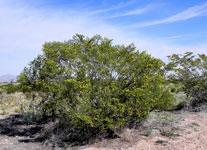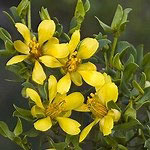Dear Friends,
As I am writing this letter, I am thoroughly enjoying Tucson. When I was living here the reduction in traffic in the summer was an indicator of how many people would head north to escape desert summers. It is indeed hot, but there are some rewards for staying in town. One is the season of the monsoon, a blessed break from the over 100 degree temperatures and the mouth parching dryness.
 You can tell when the rain is on its way when suddenly the air becomes earthy and pungent. It is an iconic desert fragrance, a gift from the creosote bush, a plant which can be found on 35 to 46 million acres in the desert southwest. It is a visually unspectacular bush, though when in bloom, it does have lovely tiny yellow flowers with fuzzy blossoms, a favorite of pollinating bees and other insects. And its age is amazing, Estimates vary from a few thousand to more than 11,000 years, likely the oldest living organism on the earth. (These estimates refer not to the age of individual plant stems which live 100 to 150 years, but to clones stemming from a single root system.)
You can tell when the rain is on its way when suddenly the air becomes earthy and pungent. It is an iconic desert fragrance, a gift from the creosote bush, a plant which can be found on 35 to 46 million acres in the desert southwest. It is a visually unspectacular bush, though when in bloom, it does have lovely tiny yellow flowers with fuzzy blossoms, a favorite of pollinating bees and other insects. And its age is amazing, Estimates vary from a few thousand to more than 11,000 years, likely the oldest living organism on the earth. (These estimates refer not to the age of individual plant stems which live 100 to 150 years, but to clones stemming from a single root system.)
I believe that the creosote bush has a few lessons for us, lessons on life, and struggle and even thriving in the midst of challenge.
The plants longevity is due to evolutionary adaptations. It only breathes in the morning. The problem all plants face is that they must “breathe” in carbon dioxide through openings on the underside of their leaves called stomata, but doing so means they lose water. This becomes a big problem when it is especially hot and dry as it always is during the day in the desert. The creosote bush only opens its stomata in the mornings when the humidity is relatively high and the loss of water is the lowest. It is during this time that it undergoes photosynthesis, and shuts it down when  the sun rises higher. This is also why it always faces southeast. Since the plant photosynthesizes only in the mornings when humidity is highest, it needs to maximize the amount of sunlight it receives during that time. Its branches and leaves grow in a shape meant to capture as much morning sunlight as possible. As the sun gets higher and the air drier, it will close its stomata and shut down its photosynthesis. While this may seem like not using the sunlight is wasted potential, it is in fact a smart move since it saves water. And in the desert it is always water, not sunlight that limits plant growth.
the sun rises higher. This is also why it always faces southeast. Since the plant photosynthesizes only in the mornings when humidity is highest, it needs to maximize the amount of sunlight it receives during that time. Its branches and leaves grow in a shape meant to capture as much morning sunlight as possible. As the sun gets higher and the air drier, it will close its stomata and shut down its photosynthesis. While this may seem like not using the sunlight is wasted potential, it is in fact a smart move since it saves water. And in the desert it is always water, not sunlight that limits plant growth.
The first and overarching lesson is on adaptability, but besides being adaptable, its lessons for us as individuals and as a community may include taking it easy, taking care of one’s self, knowing when to conserve energy, when to breathe and to always look toward the light.
Also, the creosote bush grows in different shapes depending on what it needs. A cone shape allows it to channel rain down its stems so that the water goes deeper into the soil and the roots have more time to absorb it. It can also grow into a hemisphere, an upside down bowl shape that allows leaf litter and other organic material to collect beneath its branches. And this adaptability creates an island of fertility that allows other plants and animals to live underneath, creating a rich soil that is full of nutrients for others and for the creosote bush itself. The creosote is considered a nurse plant that facilitates the growth and survival of surrounding vegetation. And so too it is considered by some to be the single most widely used and frequently employed medicinal herb in the Sonoran Desert.
So another lesson is to be adaptable with the potential of becoming an “island of fertility” where others also may thrive.
And its roots run both broad and deep. Most are shallow, to intercept any water that falls on the soil surface, but in deep sandy soils it can also produce tap roots to obtain water from deeper in the soil.
Another lesson: it is good to have deep roots, but also to be willing to branch out, to seek out opportunities for enrichment, for life and for service.
And the scent of the bush is not only an indicator of the blessed monsoon, its scent is also a warning to take cover, because that same monsoon may also prove deadly.
Perhaps that lesson is that we need to be awake and to pay attention to the world around us. How often the Bible reminds of that!
The creosote bush is one of my favorite desert teachers. But I have found that despite heat and drought, the desert is filled with survivors and thrivers, ranging from geckos to hummingbirds, saguaros to paloverdes, scorpions to bobcats.
I am reminded of the times that Jesus escaped to the desert and I wonder if it was not only to commune with God, but to learn some lessons only the desert can teach.
I invite you to consider how the lessons of the simple, unspectacular creosote might inspire you, and how it might point this church in the direction to which it is so surely being called.
Peace,
Pastor Beth




Comments are closed, but trackbacks and pingbacks are open.